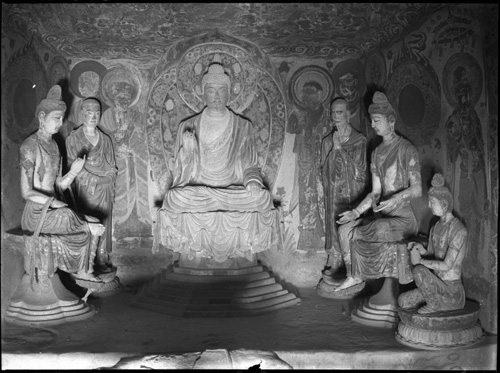PHOTO ARCHIVING - TESTIMONIALS
What Our Clients Say About Us
Princeton University
Film-to-Film Duplication and Digitize Images to CDs
In the summer of 1783, the Continental Congress convened in Nassau Hall - now one of the landmarks of the University - making Princeton the country's capital for four months. With this kind of history Princeton University, understandably, has one of the largest and most varied slide collections of any institution in the country with significant aesthetic AND historical importance.
“The University had TWO immense problems and Taylor Photo was my first and only choice."
- Shari Kenfield, Research Curator, Department of Art & Archaeology, Princeton University
Archaeological Archives Negative Duplication Project
The Research Photographs unit of the Department of Art and Archaeology maintains an archive that documents more than a century of archaeological expeditions and excavations sponsored by the department. Unfortunately these collections contained cellulose nitrate negatives which have a propensity to deteriorate and decompose.
Faced with the potential loss of thousands of these irreplaceable images, Shari Kenfield, the curator of the Research Photographs Collection selected TAYLOR PHOTO to execute an extensive duplication project .
“Taylor Photo follwed the highest current preservation and conservation standards and duplicated over 10,000 endangered archaeological negatives. These invaluable images will now be preserved for future generations of archaeologists, researchers, and historians."
Polis Excavation Negative Digitization Project
Another problem; thousands of negatives and contact sheets dating back to the late 19th century and documenting 18 years of archaeological digs, including names and details. Details - precise and precious details. These are photographic negatives and prints that were the products of large-format cameras from well-known photographers, originals that cannot be replaced.
This is an active collection – used by many within the Princeton University Community for a variety of applications and the concern focused on making these images available without placing the collection into further risk of deterioration.
The solution was to archive these negatives and contact sheets into digital format – to create images that would allow Princeton University to build a database and provide access to faculty and students via the University Intranet.
“The excavation director needed to distribute to every member of the excavation team copies of thousands of photographs that had been taken since the beginning of the excavation in 1983.
“This was an entirely different problem but Taylor Photo had the solution. They provided us a comprehensive digital archive that we have made available to every member of the excavation team. We can also print high quality reproductions whenever we need them. This was a daunting task made simple by Taylor Photo. We have absolute confidence in their abilities and wouldn’t choose anyone else for the job.”
Back to top
Andrew W. Mellon Foundation
Digitize Slide Collections of Ancient Chinese Cave Paintings
The Andrew W. Mellon Foundation is a Not-for-Profit Corporation and was formed through the consolidation of both the Old Dominion Foundation (established in 1941 in Virginia) and the Avalon Foundation (founded in December 1940 in New York).
As a Not-for-Profit Corporation The Andrew W. Mellon Foundation provides grants in the following areas:
- Higher education
- Museums and art conservation
- Performing arts
- Conservation and the environment
- Public affairs
Buddhism slowly and gently migrated north to China from India, over the ranges known as Himalaya and Karakoram and across Central Asia. It’s spread can be credited to merchants and traveling monks who pushed the boundaries of the Silk Road – the routes that carried textiles, spices and other goods between China and the known world.
It is difficult to date exactly when the idea of constructing Buddhist temples by hollowing out massive rock faces began. The cave temples and paintings at Dunhuang, staggering in their scope with nearly 500 caves, 2,000 sculptures, and 45,000 square meters of wall paintings, were begun in 366 A.D. and continued into the thirteenth century. All of what exists in the caves represents every stage of the development and evolution of Buddhism during this time.
The Lo Archive of the caves were begun in 1943 and the 18-month project utilized a remarkable system of mirrors and cloth screens devised by James Lo to reflect light along the cave corridors and illuminate the paintings and sculptures.

Thanks to the expertise of Taylor Photo, this powerful and invaluable digital archive is now part of the Visual Resources Collection and allows easy access to researchers and students.
“This work is a culmination of a life-long journey and documents some of the most important icons in Buddhism.
Taylor Photo did a remarkable job in creating a lasting archive and has helped bring hidden wonders to the world. Knowing Taylor Photo as I do, I would not have entrusted anyone else with this project.”
- Lucy Lo
Back to top
Rutgers - The State University of New Jersey
Digitize Collection of 20,000 Slides for Dbase Application
Rutgers University has more than 50,000 students on campuses located throughout New Jersey, including: Camden, Newark, and New Brunswick/Piscataway.
Chartered in 1766, Rutgers is one of the nation's major state universities with a unique history as a colonial college, a land-grant institution, and a state university.
The challenge
Rutgers University Department of Classics’ objective is to provide a comprehensive approach to the study of Greco-Roman antiquity at both the undergraduate and graduate levels. The courses that focus on the interpretation of the original texts in Latin and Greek require these texts be made available for study.
As a result, the Department of Classics needed to convert their Art Historical and Archaeological slide libraries into digital format - in order to preserve the collection and to enable images to be used as needed in Art History lectures or other presentations.
The solution
The Department of Classics at Rutgers University selected TAYLOR PHOTO to Project Manage and to digitize their entire collection of 20,000 slides. These images are now part of their digital library and the low-resolution images are used to create PowerPoint presentations.
Back to top
|